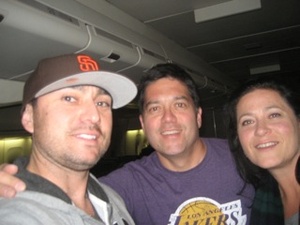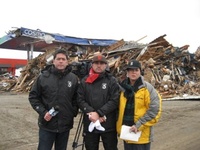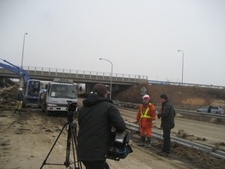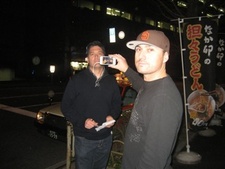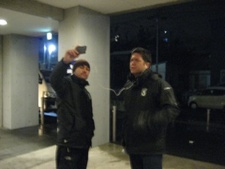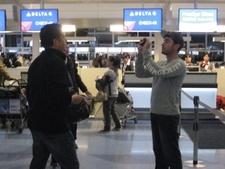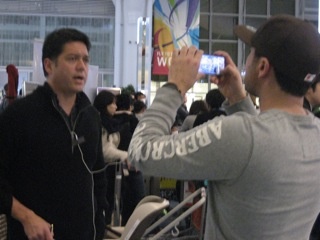I returned home from Japan last night and wanted to share a few thoughts, a few behind-the-scene moments and a link to a way you can help the Japanese people.
This assignment began a week ago Thursday night when the magnitude 9 earthquake hit. Morning News Executive Producer Tim Scowden called me at home to wake me and let me know we'd be going on early--at 4AM. He also knows that as an American with a Japanese mother, I have friends and family in Japan and that I'm involved in the Japanese American community here in the States. Tim asked me to think about how we might include some of their voices in our live coverage the next day.
After working on that, I slept for an hour and came in to KTLA. I then anchored six hours of our live coverage before heading over to Pacoima to meet up with LA County Fire's Task Force Two which was gathering its troops to deploy. I joined up with producer Toni Molle and photographer Mike McGregor and we tried to hitch a ride with them as embeds but they didn't have any room. So we booked flights for the next flight out which turned out to be 6AM Saturday. We had to take a 27-hour-long circuitous route from Los Angeles to Chicago to Detroit to Tokyo. This was the team as we flew to Tokyo.
We're smiling in the photo and in light of the events--I hope it doesn't appear insensitive or inappropriate. But at this point in our journey, we're pumped with adrenaline in anticipation of the story ahead, we're already exhausted, we're anxious about what we'll find when we land, and we're wondering how we'll cover this huge story with so many moving parts. These are the nervous smiles of a news team that doesn't know what to expect.
Upon landing, we had to sleep. We did for a few hours. Japanese authorities weren't allowing news media without Japanese government-issued special credentials to get to the scene in northeastern Japan so we decided to report on our first day from the CNN Tokyo bureau. It was a way to get the most up-to-the-minute information while providing you with live coverage from Japan. After doing live shots for the Sunday night 6 and 10PM programs and for Monday's KTLA Morning News programs, it was 1AM in Tokyo, Tuesday.
By this time, we had hired a "fixer" (a Japanese person who could make local arrangements and translate as needed) and a driver. With CNN's help, we obtained the proper credentials and began a journey to Sendai, a city of a million people closest to the epicenter of the quake which was 230 miles northeast of Tokyo.
We brought along a CNN producer (who'd just flown in from Libya) and we drove through the night in a van packed with TV gear, luggage, food and water. We expected to sleep in the van and to provide for ourselves while covering the quake. We arrived in Sendai at first light and were surprised to find...a city seemingly undamaged by the earthquake and tsunami. Turns out the city center was far enough away from the ocean that it wasn't reached by the tsunami. The quake damage, at least on the outside of the buildings was superficial. We dropped off the producer at CNN's workspace and headed toward the ocean. That's when we began to see things like this.
We're standing in front of what was once a gas station. It's piled high with the debris from homes, cars and businesses. By this time, we'd already seen a body being recovered by Japanese Self Defense Force soldiers. We'd also seen eight bodies wrapped and placed along the side of the road. We'd seen miles and miles of flattened countryside near the ocean with cars smashed and piled up, buildings reduced to their foundations. It became obvious to me the death toll--around 1,400 at this point--was going to rise. There were simply so many areas yet to be searched. It was bitterly cold and snowing at times. I wondered how the rescuers and workers were going to sustain themselves in the weeks and months ahead. I felt for the families of those missing who may never know what happened to their loved ones.
When I asked this worker who was attempting to clear debris whether there was any chance someone was alive beneath it, he said it was highly unlikely. But he did believe there were bodies buried within it.
While reporting in Sendai, we met up again with some of my former colleagues from CNN including correspondents Gary Tuchman and Anderson Cooper. We planned to use their satellite dish for transmission of our material and for our live shots. But they'd just received word from CNN headquarters that CNN was pulling out of Sendai because the nuclear power facility in Fukushima was emitting radiation and the prevailing winds would push it in our direction. Most of the CNN team was heading to Akita, about 150 miles north where there is an airport and hotels. We moved in that direction as well.
We arrived in Akita about four hours later and after checking in to a Comfort Hotel (yes, a Japanese version of the U.S. Comfort Inn), we prepared our stories. We did a series of live shots from this location and others on an iPhone 4. We didn't have access to a satellite dish and for a variety of technical reasons, a phone was our best chance to get the story out live. So Mike McGregor and I were attached to each other with a standard iPhone 4 earpiece and mic to do our liveshots via Skype. It wasn't the best quality in the world, but it allowed us to speak with you directly.
We were finished in Akita broadcasting at 1AM local time and we finally had a chance to sleep for a few hours. Upon waking, we did some more reporting for the evening news broadcasts and then it was time to fly to Tokyo. We had planned to continue reporting from Tokyo on the radiation story but after arriving in Tokyo, it became clear the radiation was prompting an exodus out of Japan. The governments of Australia and France were telling its citizens to leave Japan and expats of various nations decided it was now time to leave. I realized if we didn't change our arrangements immediately, we were probably there for the duration. At another time in my life, I would have hunkered down and prepared to cover the story. But without the medical expertise to make an informed decision about our personal safety, with a family urging me to come home, and with tickets selling out on flights to California, I decided to talk to the team. We decided together that we should head home.
Our news director Jason Ball was fully supportive. He too was concerned about our safety and wanted us out. He told me not to worry about leaving the story--that we could continue to cover it with CNN and our other resources--and not to worry about the costs of buying new tickets no matter how expensive. Fortunately, Delta Airlines, with whom we'd flown to Tokyo, had a flight leaving in just a few hours at 12:30AM on March 17th. (Japan is 16 hours ahead of Los Angeles). The telephone agent rebooked us on the flight. It was leaving from a different airport than the one we were scheduled to use on a different day on a non-refundable coach ticket. But the agent didn't require us to buy new tickets and also waived all fees because of the circumstances. The agent told me we got the last three available seats on the plane.
A few hours later, we were at Haneda International Airport where we interviewed fellow passengers who were headed to Los Angeles. We did our last series of live reports for the KTLA Morning News and then we were headed home. Was it the right decision to leave when we did? My friends and family tell me it was. But the reporter in me is troubled that I abandoned the story. The Japanese American in me feels guilty that I left Japan when I was covering such an important story for the Japanese.
Last night, we arrived back in Los Angeles. As we stepped off an escalator, a U.S. Customs agent wanded each of the passenger with a device of some sort. They didn't tell us what they were doing and when one of us asked, he said: "Just keep moving." The other agent then answered: "We're checking for isotopes." I welcomed the inspection but I didn't appreciate the approach. Passengers deserve to be treated like adults. Just tell people what you're doing.
While I was in Japan, I appreciated your thoughts and prayers--for me and my team and for the Japanese people. Many of you have asked what you can do to help the Japanese. I'm a member of the US-Japan Council, an organization dedicated to promoting relations between Japan and the U.S. through people-to-people diplomacy. The USJC has organized a relief fund of which 100% will go to Japanese NGOs and non-profits. If you'd like to contribute, here's a link.
http://usjapancouncil.org/fund
I'm off for the next few days and I know that as I get back in to the rhythm of life here in LA, my thoughts will drift back to Japan. I'll reflect upon what I've experienced and I'll appreciate every moment I have with friends and family.
*This article was originally published in the Buckley Blog on March 17, 2011. All photos are the cortesy of KTLA.
© 2011 Frank Buckley


